“Why would I add anything? It will not improve the wine.” Meet the organic vinters of LIVING WINE.
Living Wine follows the journeys of natural winemakers in Northern California, during the largest wildfire season on record. Equal parts farmer, winemaker, and artist, they stay true to their ideals of creating exceptional wines made through innovative sustainable and regenerative farming and without chemical additives. Eschewing the industrial agricultural practices of the corporate wine industry – our winemakers are healing the very environment they are surviving, i.e., a changing climate marked by rising temperatures, shorter growing seasons, and more frequent and virulent wildfires.
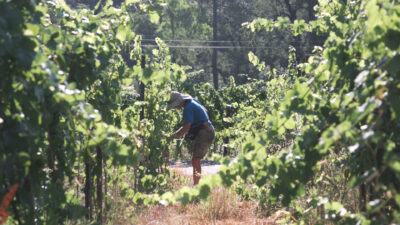
We delve into farming techniques, philosophies, and spirituality: Darek has developed a unique form of compost which eliminates the need for irrigation and commercial fertilizers, while capturing carbon and increasing crop output. Megan farms and makes wine from lesser-known materials not pushed by the corporate industrial wine complex, and we see Gideon teach and make wine with a group of interns, as he is devoted to passing his knowledge and craft onto the next generation. All three find spiritual meaning through their work – through farming the land and making a product with a greater purpose.
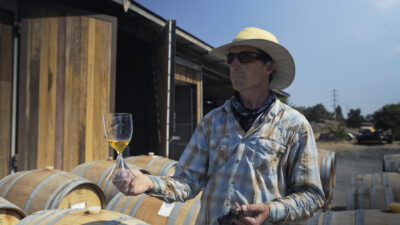
As summer and harvest arrives, conditions take a dangerous turn. Following a damaging heatwave, fire erupts throughout Northern California, the result of record high temperatures and unending drought. All of our winemakers are forced to harvest early under difficult conditions. As they pick grapes from sunrise to sunset, and throughout the night to avoid smoke taint and remove grapes before they “raisin” too early, we feel their exhaustion and determination. After harvesting, they stomp, taste, press, and taste again, and we witness both the joy and heartbreak of making wine the all-natural way.
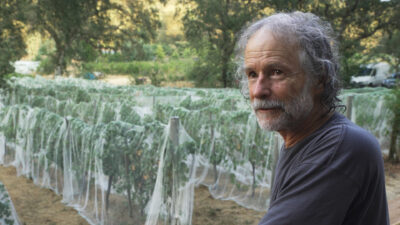
Living Wine is virtual only starting Friday, but we’ll also screen it at the Monica Film Center July 22-28 with the filmmaker in person for Q&As on the 23rd and 24th.
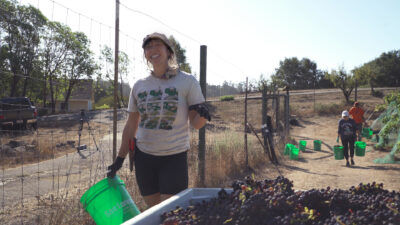
The New York Times wine critic recently published a piece about the film headlined “In ‘Living Wine’ Documentary, Natural Wine Transcends the Clichés: Forget funkiness. The focus here is farming, culture, the environment, climate change and, yes, great-tasting wine.” Here are the opening paragraphs:
“When the polarizing subject of natural wine arises, the discussion generally spirals to the stereotypes: flawed and funky wines, hippie producers and the debate over definitions. But a new documentary film, Living Wine, hopes to change that trite discussion.
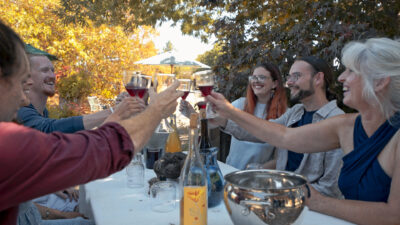
“The film, which opens in selected theaters July 15, focuses on a small group of natural wine producers in California. It examines, with far more nuance than is typical, the myriad reasons they choose to work in natural wine, along with the many rationales for consumers to drink it.
“In this context, natural wine is presented neither as a trend nor a generational emblem. Involvement is a conscious choice. Though their reasons may overlap, each of the producers in the film has a different point of emphasis.
“Gideon Beinstock and Saron Rice of Clos Saron in the Sierra Foothills make wine without additives because they believe that method makes the best wines and offers the best expression of their vineyard.
“’The fact that we don’t add anything is not because it’s natural,’ Mr. Beinstock said. ‘It’s because, why would I add anything? It will not improve the wine.’”
EatDrinkFilms also posted two terrific articles about the film, Living Wine – Land to Bottle by Risa Nye and Deep Diving into Living Wine by Fred Swan.
Moviegoers, start your guesses: The Umpteenth Annual Laemmle Oscar Contest has begun.
The Oscar nominations are out, and in spite of the fact that Bradley Cooper was robbed of one and possibly even two nominations, it’s time for our Umpteenth Annual Laemmle Oscar Contest! Correctly guess how the Academy will vote and win movie passes good at all Laemmle venues and Laemmle Virtual Cinema.
Oscar Update: Contests, KStew, Sleepers from India and Bhutan, Plus Doc, Animated and Live Action Shorts!
Please note: this year neither the animated nor live action short programs are appropriate for children.
Radu Jude on BAD LUCK BANGING OR LOONY PORN: “This was my idea — to clash these two types of obscenity, and to see that the one so-called obscenity in the porn video is nothing compared with what is around us, but that we don’t pay attention to.”
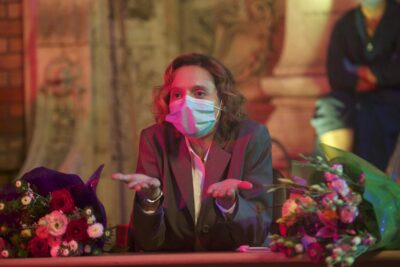
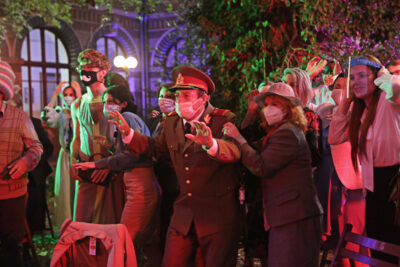
“A batshit farce. See is on a big screen with an audience to bask in their outrage.” ~ Alex Winter, actor-director, Zappa, Bill & Ted Face the Music
“An eyeball-slicing polemic by a bomb-throwing provocateur.” ~ Josh Kupecki, Austin Chronicle
“Amid so many earnest, forgettable COVID-era and COVID-acknowledging movies around the world, here’s one that truly goes for it.” ~ Michael Phillips, Chicago Tribune
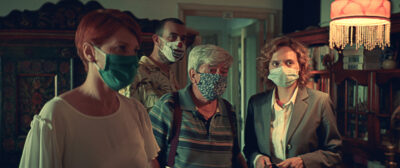
“The film first appeared out of long discussions with friends. On a few occasions we discussed real-life stories from Romania and other countries, of teachers being expelled from schools where they were teaching because of what they were doing in their private lives: live-cam sex chat or posting amateur porn recordings on the internet. The discussions were so heated, it made me think that although the topic seems trivial and shallow, there must be a lot more behind it if reactions to it are so powerful. Then I decided to make a film – so now I have the last word in front of my friends, they cannot come up with something like that.
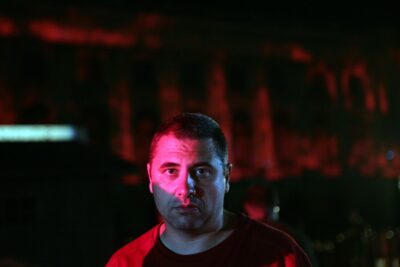
“The film has three parts which engage each other in poetic ways – understanding “poetic” according to Malraux’s definition: “Without doubt all true poetry is irrational in that it substitutes, for the ‘established’ relation of things, a new system of relations.”
“While the film title is mostly self-explanatory, its subtitle, ‘a sketch for a popular film’, could benefit from an explanation. Malraux once noted that “Delacroix, though affirming the superiority of the finished painting over the sketch, kept many of his sketches, whose quality as works of art he considered equal to that of his best paintings.” The idea struck me as relevant and I decided to apply it in filmmaking and try to see what a film would look like if its form was left open, unfinished, like a sketch. And yes, “popular”, since I believe the film could be easy like a summer breeze and because of its tabloid-like topic. But it is not a real popular film. Only a sketch of a possible one.”
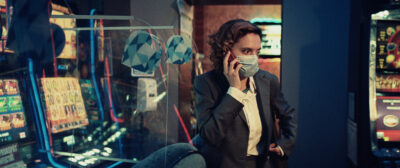
On shooting in COVID times:
“The first lockdown ended in Romania at the end of May and we were supposed to film in October and November. When we saw that the second wave of Covid-19 was coming (at the beginning of July), me and the producer Ada Solomon had to decide: either we stick to the plan (which meant also applying for extra funding), with the risk of postponing the shooting in case the crisis worsens, or we film sooner with the money we have. We opted for the latter and started to prepare the film. The number of cases was rising, so I had also to decide how to interact with people. I strongly believe that, as a director, you have a certain responsibility towards the cast and crew.
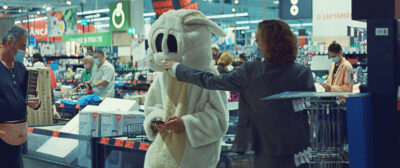
“When I was young, I really admired all the crazy shoots I read about: Way Down East, Aguirre, Apocalypse Now etc. I still admire them, but I am too weak: I try not to risk the life or health of anybody when it comes to shooting. I don’t think any film in the world is worth someone contracting even a common cold, and my bad films – even less. With these in mind, I did all the casting, and all the rehearsals on Zoom and decided to have the crew wearing masks. And also, even the cast. Firstly, because the film was supposed to be contemporary and the masks were part of our daily life and I wanted to capture this moment, to find the anthropological aspect of the mask-wearing. Secondly, because I cared about the health of the people involved. You know, many of them are in the film at my invitation. I was the host and I felt responsible. Most of the people agreed with these safety regulations. Some of them, more vulnerable, agreed to do the film only because I promised them that the rules of social distancing and protection will be severely respected. We all tested for Covid-19 before shooting and two times more.
“If you went down on the street during this time, the signs that remained — posters for concerts, empty restaurants, and so on and so forth — were already signs of a non-existent reality. Cinema has this possibility to capture things, to capture the signs of the time passing, to make a capsule of the moment in many ways.
“In the first shooting day, Ada Solomon, our producer, explained to everyone that wearing the mask is mandatory on set for the whole film, that we must change it every 4 hours (they were provided free by the production), that we have only sandwiches as catering (for obvious reasons). Everybody (literally: everybody) agreed. And most of us respected the rules, although it was exhausting, and wearing a mask in severe heat for 12 hours a day can be horrible. Then, there were some crew or cast members sometimes not respecting the rules, which made our shoot more challenging than it could have been. I am not against people who break the rules, on the contrary, if it involves only their bodies. I am against breaking the rules when you endanger or harm others. The great thing on a film set (or on my sets, anyway) is that everyone has the same rights as everyone else: the same working hours (apart from special situations, like a more time-consuming make-up etc.), the same food, the same accommodation or transport. So, it was quite disappointing to have a few people every day taking off the mask whenever they could. I see it as a lack of respect for their colleagues, a kind of “Fuck you, I don’t care about anyone else, I want to feel good even if I can infect you.” This sometimes made the atmosphere on the set tense, but that’s it. I felt relieved when the shooting ended, and we were all healthy.”
Themes
“What is obscene and how do we define it? We are used to acts which are much more obscene, in a way, than small acts like the one that set off the uproar we see in the film.
“This was my idea — to clash these two types of obscenity, and to see that the one so-called obscenity in the porn video is nothing compared with what is around us, but that we don’t pay attention to.
“The film tells a contemporary story, a small one, a little story. If history and politics are part of the film, that is because the story itself has a deeper meaning if we see it in a historical, societal and political context.
“Obscenity is the theme of this film and the viewers are constantly invited to compare the so- called obscenity of a banal amateur porn video with the obscenity around us and the obscenity we can find in recent history, whose traces are all around. So, the viewers should make this montage operation. Georges Didi Huberman wrote something very important regarding montage and it could apply to our film as well:
“Le montage sera précisément l’une des réponses fondamentales à ce problème de construction de l’historicité. Parce qu’il n’est pas orienté simplement, le montage échappe aux théologies, rend visibles les survivances, les anachronismes, les rencontres de temporalités contradictoires qui affectent chaque objet, chaque événement, chaque personne, chaque geste. Alors, l’historien renonce à raconter ‘une histoire’ mais, ce faisant, il réussit à montrer que l’histoire ne va pas sans toutes les compléxités du temps, toutes les strates de l’archéologie, tous les pointillés du destin.” *
* “Montage will be precisely one of the fundamental responses to this problem of constructing historicity. Because it is not oriented towards simplicity, Montage escapes theologies, and has the power to make visible the legacies, anachronisms, contradictory intersections of temporalities that affect each object, each event, each person, each movement. Thus, the historian renounces telling ‘a story’, but in doing so, succeeds in showing that history cannot be, without all of the complexities of time, all the archaeological strata, all of the perforated fragments of destiny.”
Oscar shortlists for International and Documentary Feature Films, including “Flee,” “Compartment No. 6,” “A Hero,” “Ascension” and “Faya Dayi.”
This week the Academy of Motion Picture Arts and Sciences announced shortlists in 10 categories for next year’s Oscars (the ceremony is March 27), including Documentary Feature and International Feature Film. We have a number of these films in or soon to be in theaters, including the double nominee, animated documentary/drama “Flee;” “Compartment No. 6,” the Finnish romantic drama set on a train travelling above the Arctic Circle; Asghar Farhadi’s latest, “A Hero;” the melancholy Japanese masterpiece “Drive My Car;” and the Norwegian romantic comedy “The Worst Person in the World.” We also have a couple of the shortlisted films available on Laemmle Virtual Cinema, the stunning portrait of Chinese society “Ascension” and Ethiopian-Mexican filmmaker Jessica Beshir’s mesmerising “Faya Dayi.” From the Academy:
Fifteen films will advance to the next round of voting in the International Feature Film category for the 94th Academy Awards. Films from 92 countries were eligible in the category.Academy members from all branches were invited to participate in the preliminary round of voting and must have met a minimum viewing requirement to be eligible to vote in the category.In the nominations round, Academy members from all branches are invited to opt in to participate and must view all 15 shortlisted films to vote.The films, listed in alphabetical order by country, are:Austria, “Great Freedom”
Belgium, “Playground”
Bhutan, “Lunana: A Yak in the Classroom”
Denmark, “Flee”
Finland, “Compartment No. 6”
Germany, “I’m Your Man”
Iceland, “Lamb”
Iran, “A Hero”
Italy, “The Hand of God”
Japan, “Drive My Car”
Kosovo, “Hive”
Mexico, “Prayers for the Stolen”
Norway, “The Worst Person in the World”
Panama, “Plaza Catedral”
Spain, “The Good Boss”
Fifteen films will advance in the Documentary Feature category for the 94th Academy Awards. One hundred thirty-eight films were eligible in the category. Members of the Documentary Branch vote to determine the shortlist and the nominees.
The films, listed in alphabetical order by title, are:
“Ascension”
“Attica”
“Billie Eilish: The World’s a Little Blurry”
“Faya Dayi”
“The First Wave”
“Flee”
“In the Same Breath”
“Julia”
“President”
“Procession”
“The Rescue”
“Simple as Water”
“Summer of Soul (…Or, When the Revolution Could Not Be Televised)”
“The Velvet Underground”
“Writing with Fire”
Laemmle Virtual Cinema: The world a click away.
the French/Tunisian documentary SHE HAD A DREAM.
See IDA Documentary Awards Nominees at Laemmle: ‘Faya Dayi,’ ‘Writing with Fire,’ ‘Not Going Quietly,’ and more.
The International Documentary Association just announced the nominees for its 37th annual awards, and we’re screening or soon to screen almost a dozen from this cinematic treasure trove:
FAYA DAYI is a triple nominee for Best Feature, Director and Cinematography and is available on Laemmle Virtual Cinema.
NOT GOING QUIETLY also garnered three nominations: Best Feature, Director and Writing. It, too, is on LVC.
We open the animated FLEE (Best Feature and Director) in January.
We have Best Feature nominee WOJNAROWICZ: F**K YOU F*GGOT F**KER now on Laemmle Virtual Cinema.
We open Best Feature nominee WRITING WITH FIRE on November 26 at the Royal.
Pare Lorentz Award Winner and Best Cinematography nominee THE FIRST WAVE opens this Friday at the Monica Film Center. The filmmaker will attend for Q&A’s after the 7:30 PM screening on Saturday, November 20 and after the 4:40 screening on Sunday, November 21.
Best Cinematography nominee ASCENSION is available now on LVC.
Best Music Documentary Nominee LYDIA LUNCH is now on LVC.
We open Best Editing Nominee PROCESSION this Friday at our Glendale theater.
Finally, we open ABC News VideoSource Award Nominee LIKE A ROLLING STONE: THE LIFE AND TIMES OF BEN FONG-TORRES November 26 at the Monica Film Center.

